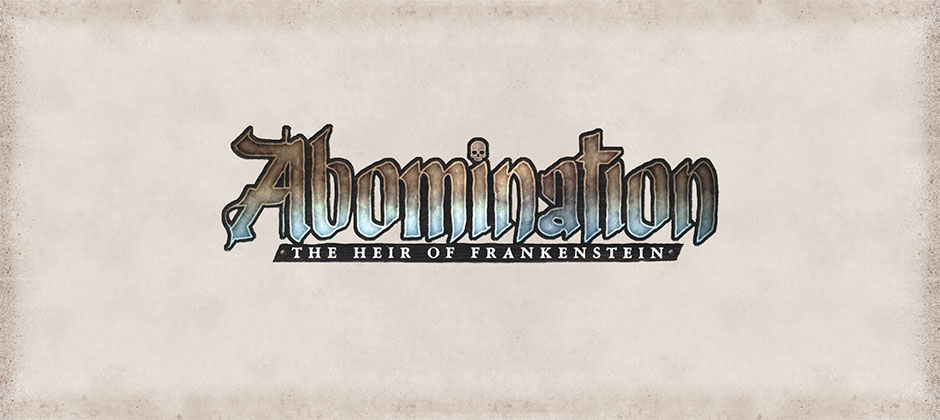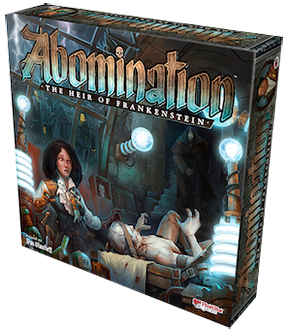The gothic strategy game of monster building.
One of my favourite genres is gothic horror, though it seems to be a theme sadly underrepresented in boardgames. So I had to get myself a copy of the new Plaid Hat Games worker placement game, Abomination: The Heir of Frankenstein, and at my request they kindly supplied me with one. I’ve been a bit underwhelmed by their last few releases, but after only one play I personally think this is the best game they’ve ever done.
Players are Victorian-era scientists racing to be the first to give life to a creature constructed of body parts. The materials required to construct those parts are muscle, organs, bone, and blood (and you can substitute animal bits for any of these if you’re prepared to lose a few victory points). Apart from bone, you’ll receive these materials in various states of freshness, depending on whether you claim your corpses straight from the hangman, dig them up from the graveyard, steal them from the morgue, or acquire them by other means…
As you construct the separate legs, arms, torso and head pieces, you place them on your player card—I love the way you literally fit the muscled body parts together on an operating table—and then have to use further resources to add skin to them. Then comes the final task of animating these lifeless bits! With the use of ‘Leyden jars’ that store electric current, you roll dice to see whether you bring your parts to life—or damage them. Of course, the first to successfully animate all 6 of their body parts ends the game; calculation of victory points reveals the final winner.
After each turn however, your materials go a bit ‘off’; moving along a track divided into 4 different stages of decomposition. Of course the fresher your materials are, the more victory points you get when you build your parts; thankfully you can buy an ice block at the market that keeps them fresh a bit longer!
Every mechanic in this game supports the theme, and it’s a pleasure to discover how they all intricately work together. You can get a fresh corpse by killing one in a back alley, but such actions reduce your humanity, and can lose you victory points, reputation and even an action meeple. By creating body parts you increase your expertise, which lets you make more complex parts and makes animating them easier. Doing good deeds and appearing at the Academy increases your reputation, which gives you more meeples to place. And it all fits together perfectly like fresh body parts on an operating table.
The worker placement and resource collection reminded me a bit of Lords of Waterdeep, but the choices are more interesting, there’s much more to do, and the theme is far more engaging. Plaid Hat, in my opinion, made the right decision to not go the ‘cartoony’ route and stay a bit grisly; the joke never gets old each time a new corpse comes up at the morgue and players are leaning over it gloating at the amount of muscle or blood they can glean from it for their experiments. It’s highly amusing to see players inevitably tempted to lower their humanity score by resorting to getting their corpses via, shall we say, less reputable avenues. And the graphic design and illustration is excellent and perfectly captures the theme.
On top of all these, there are some story elements which introduce the original Frankenstein’s monster, who is the shadowy patron of all the players’ efforts. These appear via a system derived from the Plaid Hat ‘Crossroads’ games: you draw a card and keep it until it is triggered by another player. There are only a few pages of these and they may get a bit repetitive after a few games; but then again there is a large deck of event and encounter cards and you only use a small random selection of them per game.
My criticisms are small: it outstays its welcome just a bit (our first 2 player game was 3 hours long, but I’m sure we could shave an hour off that next time); the player boards could have been a bit more sturdy; the board could have been a slightly re-designed to accommodate the card decks currently ‘off the board’; and the decision-making can get a bit too fiddly when you’re trying to calculate the best way to spend your materials and concurrently keep track of their freshness. But these are all minor quibbles.
To address the small issue of game length, Plaud Hat have already released an official Igor variant for a shorter game, and the designer’s unofficial Prometheus variant makes for a ‘more streamlined’ and shorter game (but requires some print and play elements).
If you’re at all interested in the gothic horror theme, you’ll love Abomination: The Heir of Frankenstein. It’s grisly, fun, engaging and my new favourite mid-weight worker placement game. Just don’t lose your humanity along the way …


I followed your instructions and made the foamcore insert for Abomination. I had to do a bit of improvising here and there, and I reversed one of the deck trays (for symmetry), but it came out fantastic! Thanks for the tutorials and for the well-thought-out set of plans. This storage /game-tray version will certainly make set-up quick! I’ve been learning the solo version, too, so fast setups are fantastic for that!
Well I’m really pleased to hear that Scott!